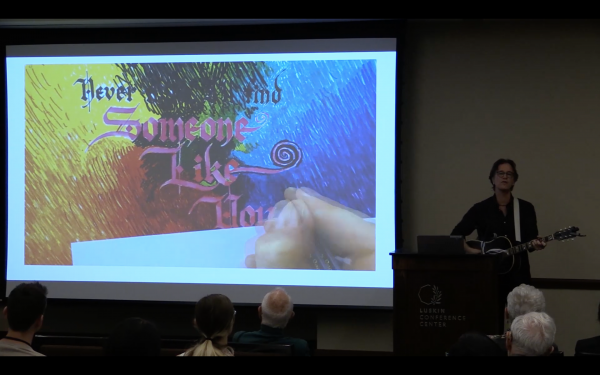On November 2 and 3, Britt Salvesen, department head and curator of photography, prints, and drawings at LACMA, and Dr. Andrew Leuchter, professor of psychiatry at UCLA, will co-host the third conference on Art, Neuroscience, and Psychiatry at UCLA. To learn more, we asked Britt and Andy to tell us more about this conference and the issues it explores.
Britt: Andy, you and I initially connected in 2016, when you were thinking about adding an art-related track to your annual conference. I've always been interested in art and science—I had just curated an exhibition of LACMA's Marjorie and Leonard Vernon Collection, connecting the history of photography to the history of vision science—so I eagerly came onboard. Where does your interest in this interdisciplinary approach come from?
Andy: A great question, Britt. In psychiatry, we work with the symbolic nature of illness more frequently than most medical specialties. The conditions that we treat not only have a strong basis in medical science, but also commonly have a deep personal meaning to our patients. In trying to understand what illness represents for a patient, we frequently work at the intersection of the arts, humanities, and medical sciences. Recent advances in neuroscience have made our work even more exciting, as we can now start to examine the neural basis of human experience. It has been great to partner with you to find new ways to explore these relationships among the arts and brain sciences.
Britt: LACMA CEO and Wallis Annenberg Director Michael Govan supported us from the beginning. I know he has a deep interest in perception and has discussed it with artists from James Turrell to Diana Thater (the latter of whom is speaking this year). Michael's talk on color, followed by a conversation with Dr. Thomas Albright on the neuroscience of architecture, was the keynote event of the 2016 conference. What are some of your highlights from previous conferences?
Andy: As you know, I have long admired Turrell’s work—seeing his retrospective and experiencing his “perceptual sphere” are personal highlights of my LACMA experiences! Michael’s panel discussion with Tom Albright on the neuroscience of perception was terrific. A highlight from last year’s conference for me was Dan Wilson’s presentation of the creative process of songwriting. His description of his creative inspirations was fascinating.
Britt: We have a lot of exceptional speakers lined up for November. I'm excited that Dr. Daniel Levitin has agreed to present a plenary talk titled "Your Brain on Music" on Friday, and he has also pulled together an amazing panel of speakers for an afternoon session on the neuroaesthetics of music: Ledisi, Dr. Steven Loza, Herb Alpert and Lani Hall, and Dr. Psyche Loui. And Dr. Antonio Damasio, who contributed to my Vernon Collection exhibition catalogue, will give a talk on Saturday. What are you most looking forward to?
Andy: All the topics for this year are great, so it is hard to choose! We have a very innovative panel this year on “What is Genius?” I am particularly excited to bring together MacArthur “Genius” Grant recipients and artists with an expert on the neuroscience of intelligence. It will explore new territory with speakers who have never shared the stage before.
Britt: I have really enjoyed the process of brainstorming topics and seeking out people who have expertise in those areas. In several cases, such as poet Gayle Brandeis and language creator David Peterson, I approached people with no prior acquaintance and have been truly gratified by their positive responses to our invitation. Your colleagues on the neuroscience side seem equally enthusiastic about this forum. Could you say a bit more about that?
Andy: Britt, I have had the same experience with my neuroscience colleagues. Our increased understanding of the brain allows us to address questions about the neuroscience of perception, aesthetic experience, and creativity that we never have been able to examine before. Our neuroscience and clinician colleagues welcome the opportunity to explore these topics with artists, writers, musicians, and others from outside of STEM fields.
Britt: Another constituency I'd like to acknowledge is our audience. The conference structure includes time for receptions and socializing, so there is ample opportunity for constructive conversations with attendees, including academics, clinicians, artists, and students. We know we'll have many "repeat customers" this year. What would you say to first-timers to encourage them to join us in November?
Andy: This conference is unique in the breadth of the audience. We find clinicians and scientists having lively lunch discussions with artists and musicians, comparing perspectives on the the brain and human experience. There is no other opportunity like this in the country! I hope that we will see many new faces in the audience this fall.
Britt: I would add, for LACMA's audience, that this year's Art, Neuroscience, and Psychiatry conference touches on themes also addressed in our upcoming exhibition, Outliers and American Vanguard Art, curated by Lynne Cooke and opening here on November 18.
To see the complete program and to register for one or both days, please visit the conference website. This conference takes place at UCLA Meyer and Renee Luskin Conference Center, 425 Westwood Plaza, Los Angeles, California, 90095.



